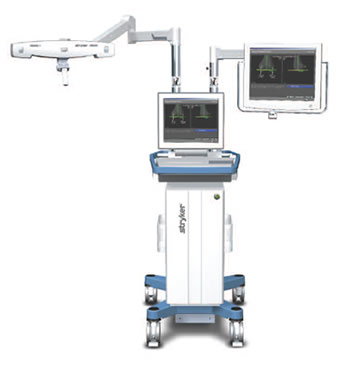Cutting Edge Technology for Joint Replacements (Continued)
Potential Benefits of Computer-Assisted Surgery
- May help to reduce joint wear and extend the life of the implant1, 2 Computer-assisted surgery may allow for less-invasive surgical techniques, which have other potential advantages, including:
- Shorter post-operative physical rehabilitation3
- Smaller incision4
- Less blood loss compared to a standard knee replacement5

What Happens During Surgery?
Stryker Navigation technology uses special tracking devices, providing your surgeon a comprehensive understanding of your joint mechanics in the operating room (OR). Armed with this information, your surgeon can make adjustments within a fraction of a degree, helping to ensure your new joint has the stability and range of motion needed for a successful replacement.
Specifically, the technology uses the latest advancements in science and computer engineering to help contribute to accurate positioning of the implants. As the surgeon moves an instrument within your joint, special infrared trackers calculate its position and wireless instruments instantaneously transfer the data to a computer in the OR. This information is then displayed on a monitor as an interactive model of the anatomy or “blueprint” that supplies the surgeon with the angles, lines and measurements of your unique anatomy.
The surgeon will then replace the diseased bone with new, artificial joint components often called prostheses or implants. Joint implants are engineered to closely replicate a normal, healthy joint.
With certain techniques, your surgeon may use pins that hold trackers around the incision site of your joint. These temporary placeholders give the computer key information and may make the surgery even more exact, but it does mean the possibility of additional scarring at the pin points.
Remember, even if your doctor recommends hip or knee replacement for you, the final decision is yours.
Talk to your doctor about the types of joint surgery appropriate for you and the risks associated with any surgery.
For more information visit AboutStryker.com, and contact your doctor.
References:
1. Coventry MB. Two-part total knee arthroplasty: evolution and present status. Clin Orthop 1973; 145: 29-36.
2. Lotke PA, Ecker ML. Influence of positioning of prosthesis in total knee replacement. J Bone Joint Surg [Am] 1977; 59-A: 77-9.
3. Zanasi, Stefano. Minimally invasive computer-assisted total Knee arthroplasty through a subvastus approach, Oct. 2006. Article from: Orthosupersite.com, accessed Feb. 2011.
4. Keggi, Kristaps. Total hip arthroplasty through a minimally invasive anterior surgical approach, JBJS, Vol. 85-A.
5. Kalairajah, et al., Blood loss after total knee replacement, JBJS, Vol. 87-B, No. 11, Nov. 2005.
